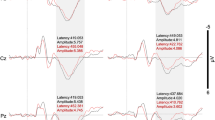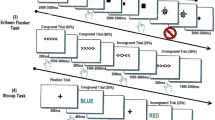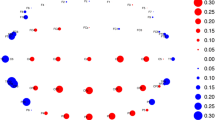Abstract
Background
The current study is a reanalysis in the time domain of EEG data collection in healthy adults during an oddball paradigm using levetiracetam (LEV) vs. placebo acute administration. Specifically, the event-related potential (ERP) technique provides a tool for exploring the EEG responses to a specific event/stimulus. One of the ERP components widely studied is the P300 component, which is associated with the last stage of information processing and a general measurement of “cognitive efficiency.”
Methods
The sample was composed of thirteen healthy right-handed individuals randomized to participate under two conditions: LEV and placebo. Electrophysiological measures were collected before and after drug intake. We explored the oddball paradigm, which is commonly used with healthy individuals to investigate the stages of information processing.
Results
The electrophysiological results showed a main effect of condition on P300 amplitude for the frontal (F3, Fz, F4), central (C3, Cz, C4), and parietal electrodes (P3, Pz, P4). The post hoc comparisons (Scheffé’s test) demonstrated the significant differences between electrodes. Regarding P300 latency, all regions represented a main effect of condition. A P300 latency reduction was observed during LEV condition compared with placebo.
Conclusion
Our study observed the ERP component—P300—through the variation of its amplitude and latency to evaluate a supposed higher CNS efficiency when participants were under the LEV effect. Our findings sustain this premise, mainly due to reducing in P300 latency for the LEV condition, supporting the neural efficiency hypothesis.



Similar content being viewed by others
References
Lynch G, Cox CD, Gall CM (2014) Pharmacological enhancement of memory or cognition in normal subjects. Front Syst Neurosci 8:90
Woods DL, Kishiyamaa MM, Lund EW, Herron TJ, Edwards B, Poliva O, Hink RF, Reed B (2011) Improving digit span assessment of short-term verbal memory. J Clin Exp Neuropsychol 33(1):101–111
Cortes-Altamirano JL, Olmos-Hernández A, Bonilla-Jaime H, Bandala C, González-Maciel A, Alfaro-Rodríguez A (2016) Levetiracetam as an antiepileptic, neuroprotective, and hyperalgesic drug. Neurol India 64(6):1266–1275
Bakker A, Krauss GL, Albert MS, Speck CL, Jones LR, Stark CE, Yassa MA, Bassett SS, Shelton AL, Gallagher M (2012) Reduction of hippocampal hyperactivity improves cognition in amnestic mild cognitive impairment. Neuron 74(3):467–474
Light GA, Williams LE, Minow F, Sprock J, Rissling A, Sharp R, Swerdlow NR, Braff DL (2010) Electroencephalography (EEG) and event-related potentials (ERPs) with human participants. Curr Protoc Neurosci chapter 6:unit 6.25.1-24. https://doi.org/10.1002/0471142301.ns0625s52
Polich J (2007) Updating P300: an integrative theory of P3a and P3b. Clin Neurophysiol 118(10):2128–2148
Magalhães JC, Gongora M, Vicente R, Bittencourt J, Tanaka G, Velasques B, Teixeira S, Morato G, Basile L, Arias-Carrión O, Pompeu F, Cagy M, Ribeiro P (2015) The influence of levetiracetam in cognitive performance in healthy individuals: neuropsychological, behavioral and electrophysiological approach. Clin Psychopharmacol Neurosci 13(1):83–93
Oldfield R (1971) The assessment and analysis of handedness: the Edinburgh inventory. Neuropsychologia 9(1):97–113
Hopkins W, Marshall S, Batterham A, Hanin J (2009) Progressive statistics for studies in sports medicine and exercise science. Med Sci Sports Exerc 41(1):3–13
Mecarelli O, Vicenzini E, Pulitano P, Vanacore N, Francesco Saverio Romolo, Piero VD, Lenzi GL, Accornero N (2004) Clinical, cognitive, and neurophysiologic correlates of short-term treatment with carbamazepine, oxcarbazepine, and levetiracetam in healthy volunteers. Ann Pharmacother 38:1816–1822
Daliento L, Mapelli D, Volpe B (2006) Measurement of cognitive outcome and quality of life in congenital heart disease. Heart 92(4):569–574
Djamshidian A, O'Sullivan SS, Lees A, Averbeck BB (2011) Stroop test performance in impulsive and non impulsive patients with Parkinson's disease. Parkinsonism Relat Disord 17(3):212–214
Davydov DM, Polunina AG (2004) Heroin abusers' performance on the tower of London test relates to the baseline EEG alpha2 mean frequency shifts. Prog Neuro-Psychopharmacol Biol Psychiatry 28:1143–1152
Klem GH, Lüders HO, Jasper HH, Elger C (1999) The ten-twenty electrode system of the international federation. The International Federation of Clinical Neurophysiology. Electroencephalogr Clin Neurophysiol Suppl 52:3–6
Iriarte E, Urrestarazu M, Valencia M, Alegre A, Malanda C, Viteri J, Artieda J (2003) Independent component analysis as a tool to eliminate artifacts in EEG: a quantitative study. J Clin Neurophysiol 20(4):249–257
Ferreira E, Rocha C, Mequelino B (2012) Monte Carlo evaluation of the ANOVA's F and Kruskal-Wallis tests under binomial distribution. Sigmae. 1(1):126–139
Mena B, José M, Alarcón R, Arnau Gras J, Bono Cabré R, Bendayan R (2017) Non normal data: Is ANOVA still a valid option? Psicothema. 29(4):552–557
Schmider E, Ziegler M, Danay E, Beyer L, Bühner M (2010) Is it really robust? Reinvestigating the robustness of ANOVA against violations of the normal distribution assumption. Methodology. 6:147–151
Meador KJ, Gevins A, Loring DW, McEvoy LK, Ray PG, Smith ME, Motamedi GK, Evans BM, Baum C (2007) Neuropsychological and neurophysiologic effects of carbamazepine and levetiracetam. Neurology 69(22):2076–2084
Costa A, Oliveri M, Barban F, Bonnì S, Koch G, Caltagirone C, Carlesimo A (2013) The right frontopolar cortex is involved in visual-spatial prospective memory. PLoS One 8(2):e56039
Farr OM, Zhang S, Hu S, Matuskey D, Abdelghany O, Malison RT, Li CSR (2014) The effects of methylphenidate on resting- state striatal, thalamic and global functional connectivity in healthy adults. Int J Neuropsychopharmacol 17:1177–1191
Demeter E, Sarter M (2013) Leveraging the cortical cholinergic system to enhance attention. Neuropharmacology 64:294–304
Lanzilotto M, Perciavalle V, Lucchetti C (2015) Evidence for a functional subdivision of premotor ear-eye field (area 8B). Front Behav Neurosci 8:454
Sur S, Sinha V (2009) Event-related potential: an overview. Ind Psychiatry J 18(1):70–73
Rogawski M (2006) Diverse mechanisms of antiepileptic drugs in the development pipeline. Epilepsy Res 69(3):273–294
Tripathi S, Mishra N, Tripathi R, Gurnani K (2015) P300 latency as an indicator of severity in major depressive disorder. Ind Psychiatry J 24(2):163–167
Fond G, Micoulaud-Franchi JA, Brunel L, Macgregor A, Miot S, Lopez R, Richieri R, Abbar M, Lancon C, Repantis D (2015) Innovative mechanisms of action for pharmaceutical cognitive enhancement: a systematic review. Psychiatry Res 229(1–2):12–20
Bensmaia SJ (2015) Biological and bionic hands: natural neural coding and artificial perception. Philos Trans R Soc Lond Ser B Biol Sci 370(1677):20140209
Li Hegner, Y., Lindner, A., Braun, C (2015). Cortical correlates of perceptual decision making during tactile spatial pattern discrimination. Hum Brain Mapp. 36(9): 3339–3350
Mertens R, Polich J (1997a) P300 from a single-stimulus paradigm: passive versus active tasks and stimulus modality. Electroencephalogr Clin Neurophysiol 104:488–497
Fleming M, Stinear C, Byblow W (2010) Bilateral parietal cortex function during motor imagery. Exp Brain Res 201(3):499–508
Meehan A, Yang X, Yuan L, Rothman S (2012) Levetiracetam has an activity-dependent effect on inhibitory transmission. Epilepsia. 53(3):469–476
Reep R, Chandler H, King V, Corwin J (1994) Rat posterior parietal cortex: topography of corticocortical and thalamic connections. Exp Brain Res 100:67–68
Himmelbach M, Nau M, Zündorf I, Erb M, Perenin M, Karnath H (2009) Brain activation during immediate and delayed reaching in optic ataxia. Neuropsychologia. 47:1508–1517
Schultz S, North S, Shields C (2007) Schizophrenia: a review. Am Fam Physician 75:1821–1829
Hermens D, Williams L, Clarke S, Kohn M, Cooper N, Gordon E (2005) Responses to methylphenidate in adolescent AD/HD: evidence from concurrently recorded autonomic (EDA) and central (EEG and ERP) measures. Int J Psychophysiol 58(1):21–33
Donchin E (1979) Event-related brain potentials: a tool in the study of human information processing. In: Begleiter H (ed) Evoked potentials and behavior. Plenum, New York
Author information
Authors and Affiliations
Corresponding author
Ethics declarations
Conflict of interest
The authors declare that they have no conflict of interest for this research and this paper.
Ethical approval
None.
Additional information
Publisher’s note
Springer Nature remains neutral with regard to jurisdictional claims in published maps and institutional affiliations.
Rights and permissions
About this article
Cite this article
Gongora, M., Nicoliche, E., Magalhães, J. et al. Event-related potential (P300): the effects of levetiracetam in cognitive performance. Neurol Sci 42, 2309–2316 (2021). https://doi.org/10.1007/s10072-020-04786-8
Received:
Accepted:
Published:
Issue Date:
DOI: https://doi.org/10.1007/s10072-020-04786-8




